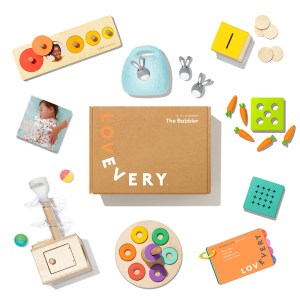5 ways to play the pompom way

Pompoms—small multicoloured cotton balls—are so simple and so fun for your toddler. They’re great for fine motor development activities like tweezing, sorting, and poking small objects through holes.
Here are some ideas for pompom play at home or on the go:
Note: pompom play should always be supervised. These little soft balls can be a choking hazard, so be sure to keep your toddler within reach, especially if they like to put things in their mouth.
Poking
Poke the pompoms through the top of an empty milk or juice carton (the kind with the small spout, shown above). Cut out a flap from the bottom, so your toddler can retrieve the pompoms easily and poke them through over and over again.
If you don’t have a carton, try having your toddler push them through the top of an old plastic water bottle.
Tweezing

You might think your active toddler wouldn’t be into deep-focus, Montessori-style transferring activities, but as they get closer to two years old, they will have enough hand-eye coordination to get really engaged in it.
They will love using the tweezers to practice transferring pompoms, blueberries, peas, or other small items from one container to another. Even If your toddler isn’t interested in tweezers, they may still find the activities engaging using their fingers, and the practice is great for their fine motor and cognition skills.
Hiding

Hide the pompoms and the felt stars in the Magic Tissue Box, along with some hard objects like small rocks or toys. Talk about the difference between soft and hard, things that are round and things that have edges. Then ask your toddler to put their hand in the box, feel around without looking, and pull out the objects in each category: soft, round, hard, and shapes with points.
Sorting

Tweeze and sort the pompoms and felt stars by colour into the Nesting Stacking Drip Drop Cups. If you have both larger and smaller pompoms, your toddler can also sort them by size. Toddlers begin to enjoy sorting by colour, type, and size somewhere between 18 and 24 months. They can also sort pompoms into a muffin tin or egg carton.
Sticking

Your toddler can stick the pompoms to your window or wall using clear transfer paper (this paper is slightly sticky and clear and can be found here). Use painter’s tape to attach the transfer paper to a window, the floor, or a table—sticky side out—and let your toddler stick and unstick the pompoms.

The Play Kits
The Play Kits by Lovevery are thoroughly tested, baby safe, eco-friendly and Montessori inspired. Give your child the best start with our stage-based play toy subscription boxes.
Learn morePosted in: 19 - 21 Months, Fine Motor, Playtime & Activities, Sorting, Child Development
Keep reading

19 - 21 Months
22 - 24 Months
25 - 27 Months
28 - 30 Months
31 - 33 Months
34 - 36 Months
What kind of chores are right for my child?
Children as young as 18 months can start taking on regular household responsibilities. These will be simple and straightforward, like wiping up spills or helping set the table, and will require modeling and patience from you.


19 - 21 Months
Welcome to The Realist Play Kit for months 19-21
Watch Lovevery CEO Jessica Rolph introduce the Realist Play Kit for months 19 to 11 of your toddler's life.


19 - 21 Months
Introducing the Montessori Animal Match game to your toddler
Lovevery CEO Jessica Rolph and Montessori Expert Jody Malterre demonstrate how the Montessori Animal Match game helps toddlers link 2D images with 3D figurines.
